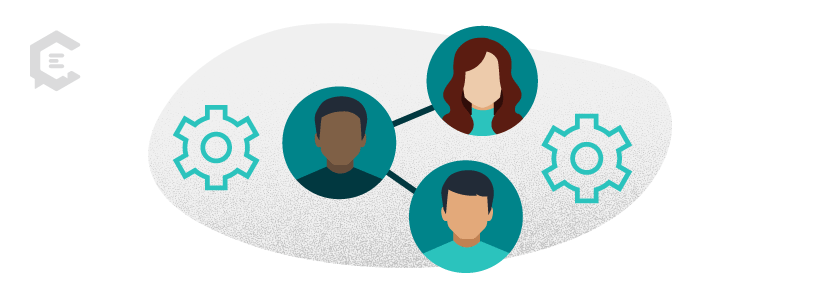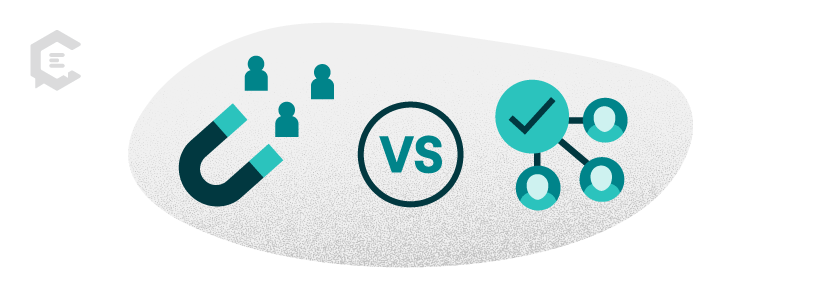What is demand generation?
Demand generation is a marketing strategy that marries your sales and marketing teams through initiatives designed to generate interest in your product or service (read: demand) and ultimately convert leads into customers. It is an umbrella term that encompasses both lead generation and inbound marketing.
Since your demand generation strategy incorporates both your sales and marketing teams, demand generation will also require leading your customer through all of the stages of the buyer’s journey.
Why is demand generation important?
Without demand generation, you’re simply casting a wide net with your marketing and waiting to see what comes in. That’s fine if you’ve got plenty of money to burn, but most marketing teams are being asked to do more with less these days.
So how do you get more bang for your buck? By making sure you’re reaching the right audience with your marketing.
A cohesive strategy – like demand generation – employs both your sales and marketing teams to achieve that end. Marketing might bring in leads, but demand generation brings in qualified leads. When done well, demand generation also
- Bolsters brand awareness
- Reduces customer acquisition costs
- Drives greater revenue and profitability
How do you develop a demand generation strategy?
As with all things marketing, you’ll first start by understanding your target audience. Who are you trying to reach? Where will you find them? And what do they respond to?
You’ll also want to define clear goals for your strategy. Make sure they are SMART:
- Specific
- Measurable
- Achievable
- Relevant
- Time-Bound
Be sure to establish how will you measure whether or not you’re reaching those goals. What key performance indicators (KPIs) will you use?
Remember that demand generation (just like content marketing) is a long game. Take a best-practice approach:
- Develop buyer personas. Include a description of your ideal customer, what they want, their pain points, how you can help them, and what types of messaging and interaction engage and motivate them to buy.
- Include thorough SEO/SEM strategies. Your research should include keyword strategy, SEO tactics, and SEM tools such as paid search advertising to determine what attracts and retains customers who fit your buyer personas. Use data to optimize your website and generate those leads.
- Implement inbound marketing tactics. Leverage numerous types of content, such as videos, emails, whitepapers and reports, social media, and blogs, to build a case for why buyers should choose your product or service.
- Create high-quality content. Content such as white papers, press releases, ebooks, and articles provide credibility, while social media conversations, email campaigns, and blog posts help solidify relationships and generate interest. Your content makes the first impression and provides the engagement to keep these relationships going.
- Remember the different stages of the buyer’s journey. The content you create should reflect where your customers are in their buyer’s journey. Not all content is created equal! When you personalize the content, it further strengthens those bonds and may even transform your customer into a brand advocate.
- Partner with the sales team whenever possible. The perspectives and skills of both teams can improve the marketing and sales enablement content and deepen the personalization methods you utilize.
Lead Generation vs. Demand Generation
All lead generation is demand generation, but not all demand generation is lead generation.
Lead generation is exactly what it sounds like – it is a strategy typically implemented by sales teams to bring in leads. However, it is part of a larger demand generation strategy wherein the sales and marketing teams work together to create qualified leads for the sales team.
Put another way, lead generation starts the process of attracting prospects and hands them off to the sales team. It’s then up to the sales team to qualify those leads.
Demand generation continues to work long after the lead converts.
Because a lead doesn’t have to be a brand-new customer. Sometimes your best leads are existing customers! That’s why lead nurturing is also part of a demand generation strategy. Stay in regular contact with your existing customers, provide them with targeted, personalized content, and see plenty of return on that investment.
Get Started with Demand Generation
You can start by consulting your sales and marketing teams on creating a holistic strategy that serves everyone’s needs. Or you can save time (and money!) by connecting with us.
At ClearVoice, we want to be your long-term partner in creating content that makes both your sales and marketing teams happy. We understand the big picture, and a content strategy session is your first step toward building a demand-generation strategy that reaches your target audience.






